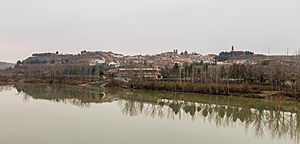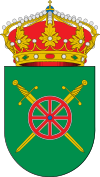Escatrón facts for kids
Quick facts for kids
Escatrón
|
|||
|---|---|---|---|
 |
|||
|
|||
| Country | |||
| Autonomous community | |||
| Province | Zaragoza | ||
| Municipality | Escatrón | ||
| Area | |||
| • Total | 95 km2 (37 sq mi) | ||
| Elevation | 140 m (460 ft) | ||
| Population
(2018)
|
|||
| • Total | 1,026 | ||
| • Density | 10.80/km2 (27.97/sq mi) | ||
| Time zone | UTC+1 (CET) | ||
| • Summer (DST) | UTC+2 (CEST) | ||
Escatrón is a small town, also known as a municipality, located in the Ribera Baja del Ebro area in Spain. It is part of the province of Zaragoza in the region of Aragon. In 2018, about 1,026 people lived there. Escatrón is known for its history and its location near the Ebro River.
Contents
Where is Escatrón?
Escatrón is found in northeastern Spain. It sits on the right bank of the Ebro River, which is one of the longest rivers in Spain. The town is about 75 kilometers (47 miles) southeast of Zaragoza, the capital city of the province. Its location by the river has been important for its development over time.
Geography and Nature
The area around Escatrón is mostly flat, typical of a river valley. You can see fields and some hills. The climate here is dry, with hot summers and cool winters. The Ebro River provides water for farming, which is a big part of life in the region.
A Look at Escatrón's History
Escatrón has a long and interesting history. People have lived in this area since ancient times.
Early Settlements
Evidence shows that people lived here even before the Roman Empire. Later, the Romans built roads and settlements in the region. After the Romans, the area was influenced by Visigoths and then by Muslims for several centuries.
Medieval Times
During the Reconquista, Christian kingdoms slowly took back land from Muslim rule. Escatrón was conquered by Alfonso I of Aragon in 1133. After this, it became part of the Kingdom of Aragon. The town's location near the river made it important for trade and defense.
Modern Era
In more recent times, Escatrón has continued to be an agricultural town. The construction of the Mequinenza Dam in the 20th century changed the landscape and economy of the region, affecting the Ebro River's flow near Escatrón.
What to See in Escatrón
Escatrón has some interesting places to visit that show its history and culture.
Church of San Salvador
The main church in Escatrón is the Church of San Salvador. It was built in the 17th century in the Baroque style. It has a tall bell tower and beautiful altarpieces inside. It is a central part of the town's religious life.
Monastery of Rueda
Just a few kilometers from Escatrón is the Monastery of Rueda. This is a very important historical site. It was built by Cistercians in the 12th century. The monastery is known for its impressive architecture, including a large cloister and a waterwheel system that used the river's power. It's a great example of medieval engineering and religious life.
The Ebro River
The Ebro River is a natural landmark itself. It offers opportunities for fishing and enjoying nature. The river has shaped the town's landscape and its way of life for centuries.
Life and Culture in Escatrón
Life in Escatrón is typical of a small Spanish town, with strong community ties and local traditions.
Local Economy
The economy of Escatrón is mainly based on agriculture. Farmers grow crops like olives, peaches, and other fruits. Some people also work in services or small local businesses.
Festivals and Traditions
Like many Spanish towns, Escatrón celebrates several festivals throughout the year. These often involve religious processions, music, dancing, and traditional food. These events are important for bringing the community together.
Daily Life
Children in Escatrón attend local schools. Families often gather for meals and spend time outdoors. The town offers a quiet lifestyle, connected to its natural surroundings and historical roots.
See also
 In Spanish: Escatrón para niños
In Spanish: Escatrón para niños



